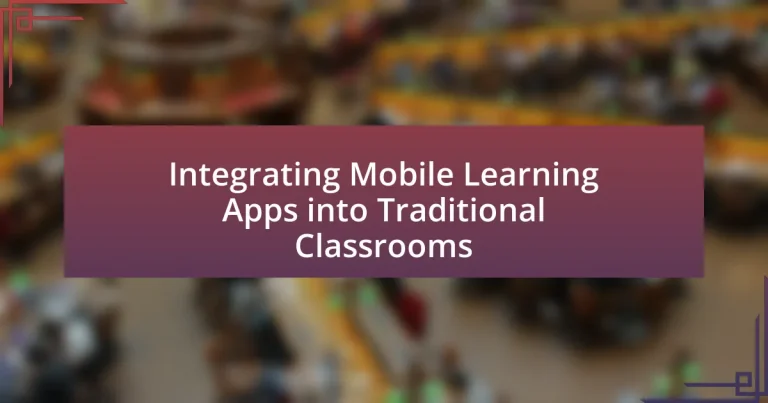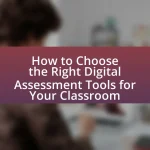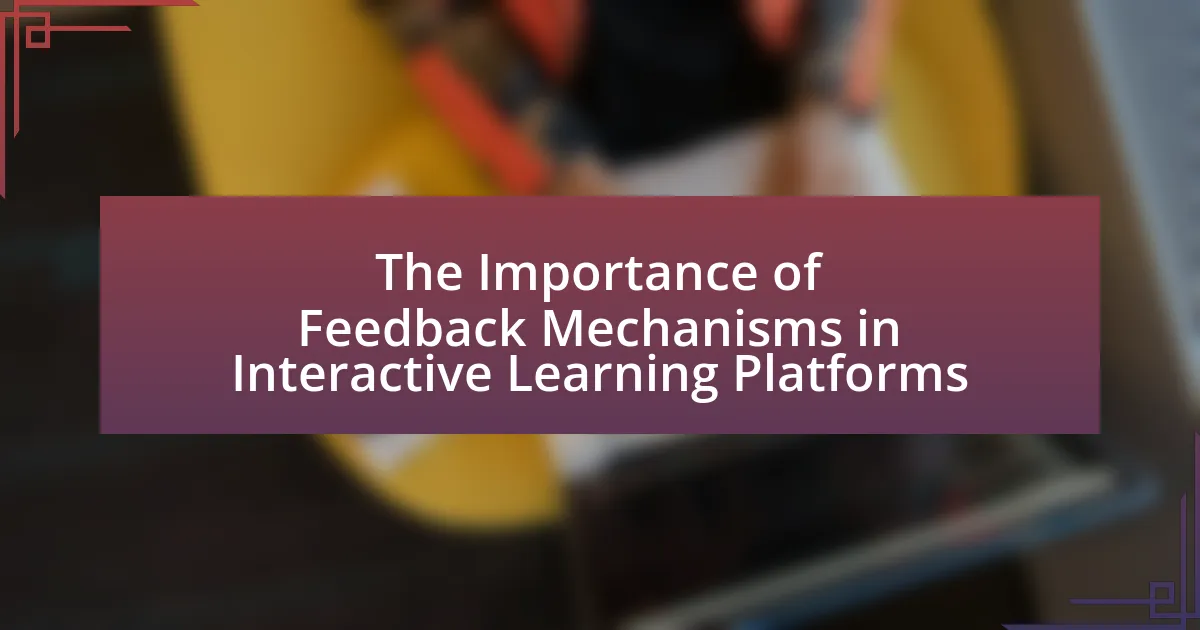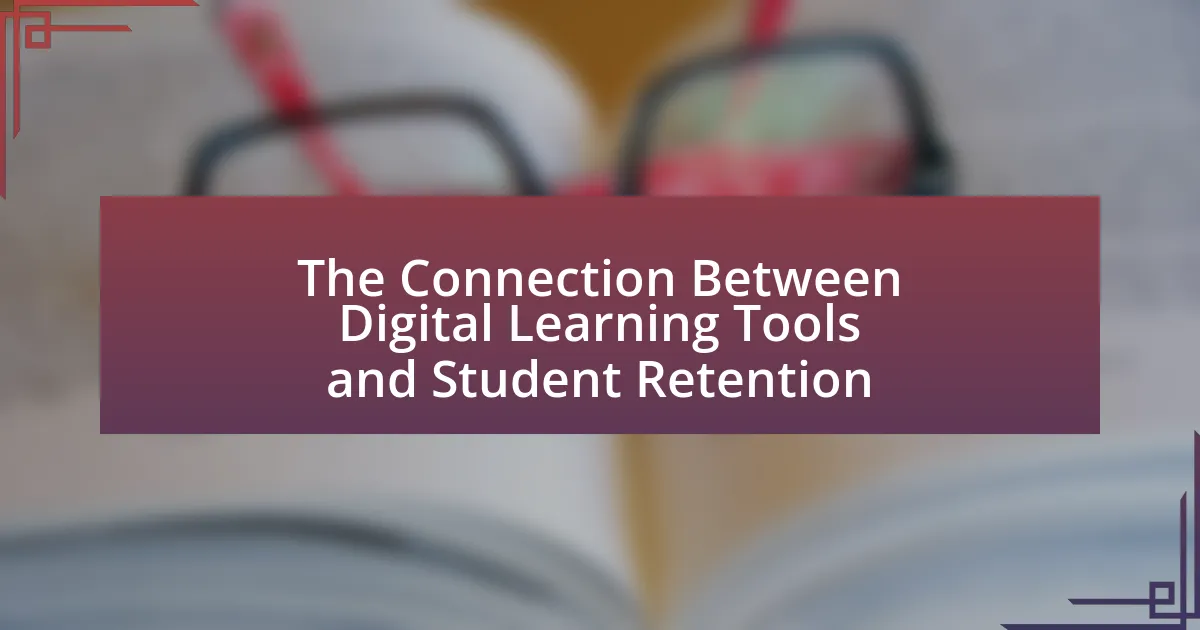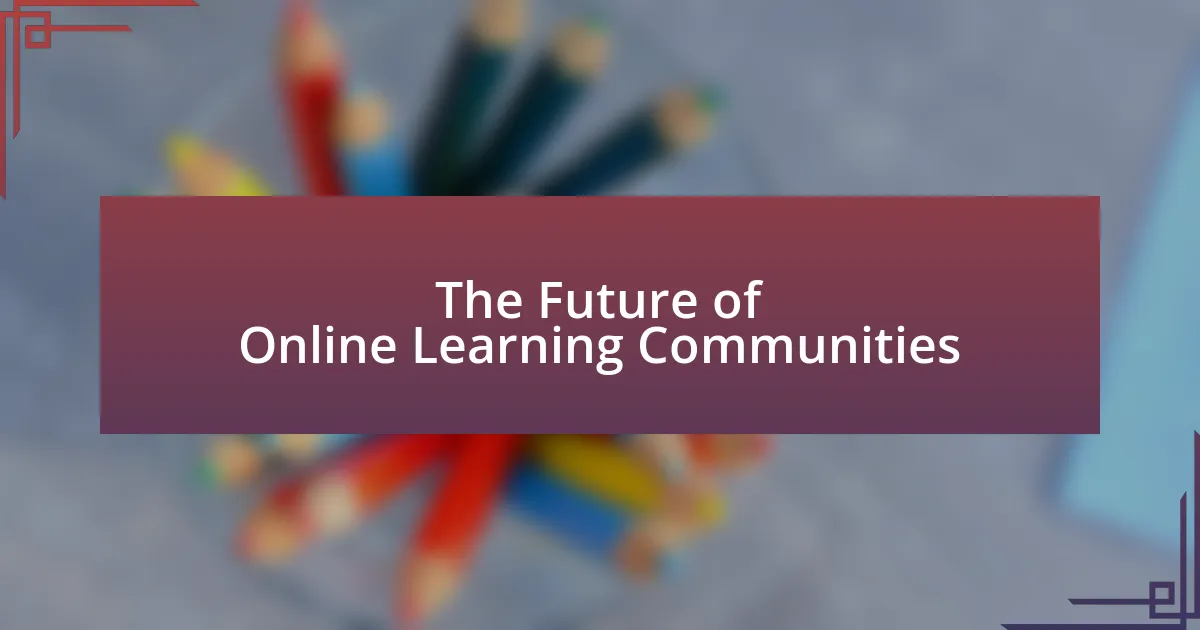Integrating mobile learning apps into traditional classrooms involves the incorporation of digital tools that enhance educational experiences through mobile devices. This process includes selecting suitable applications, training educators, and ensuring student access to technology. The article explores how mobile learning apps improve student engagement and learning outcomes, address diverse learning styles, and support modern educational trends. It also discusses the challenges of integration, such as technological disparities and resistance to change, while providing strategies for effective implementation and evaluation of mobile learning tools in educational settings.
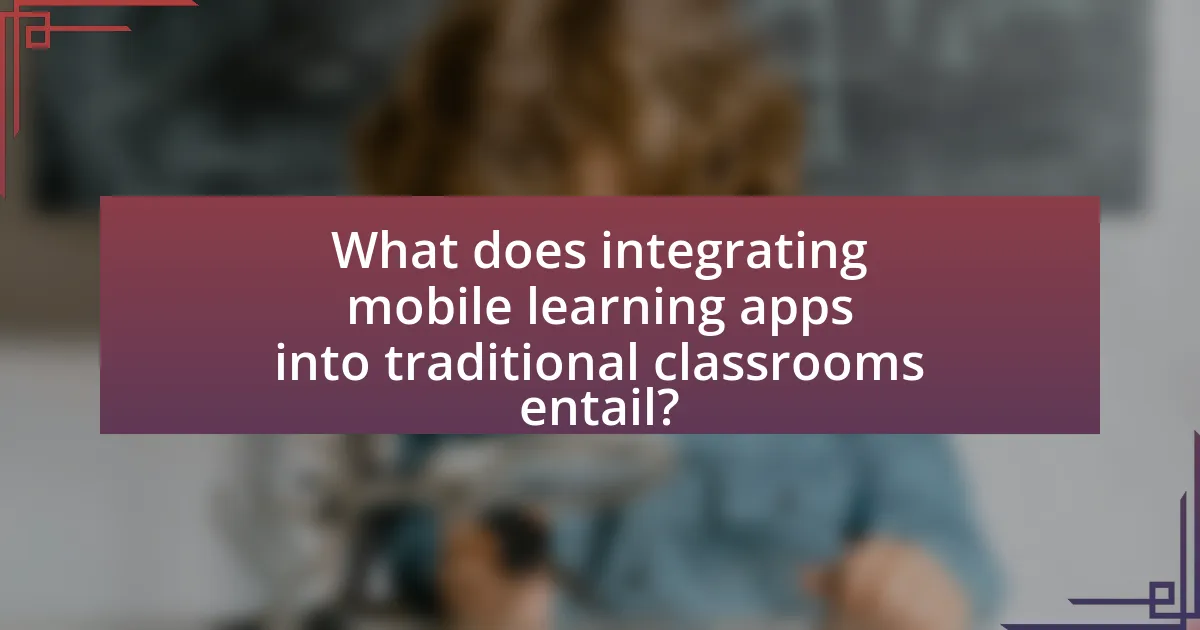
What does integrating mobile learning apps into traditional classrooms entail?
Integrating mobile learning apps into traditional classrooms entails the incorporation of digital tools that facilitate learning through mobile devices. This process involves selecting appropriate applications that align with educational objectives, training educators to effectively use these tools, and ensuring that students have access to the necessary technology. Research indicates that mobile learning can enhance student engagement and improve learning outcomes, as evidenced by a study published in the Journal of Educational Technology & Society, which found that mobile apps can increase motivation and facilitate personalized learning experiences.
How do mobile learning apps enhance traditional classroom experiences?
Mobile learning apps enhance traditional classroom experiences by providing personalized learning opportunities and immediate access to resources. These apps allow students to engage with content at their own pace, catering to diverse learning styles and needs. For instance, a study published in the Journal of Educational Technology & Society found that students using mobile learning apps demonstrated improved academic performance and engagement compared to those relying solely on traditional methods. This integration of technology fosters collaboration and communication among students and teachers, further enriching the educational experience.
What features of mobile learning apps are most beneficial in a classroom setting?
Mobile learning apps that enhance classroom settings typically include features such as interactive content, real-time feedback, and collaborative tools. Interactive content, such as quizzes and simulations, engages students actively, promoting better retention of information. Real-time feedback allows educators to assess student understanding immediately, facilitating timely interventions. Collaborative tools enable group work and communication among students, fostering teamwork and enhancing learning outcomes. Research indicates that these features significantly improve student engagement and academic performance, as evidenced by studies showing increased participation rates and higher test scores in classrooms utilizing such apps.
How do mobile learning apps cater to different learning styles?
Mobile learning apps cater to different learning styles by incorporating various features that address visual, auditory, and kinesthetic preferences. For instance, apps often include multimedia elements such as videos and infographics for visual learners, audio recordings and podcasts for auditory learners, and interactive simulations or gamified activities for kinesthetic learners. Research indicates that personalized learning experiences enhance engagement and retention; a study by the Bill & Melinda Gates Foundation found that adaptive learning technologies can significantly improve student outcomes by aligning with individual learning preferences. This adaptability in mobile learning apps ensures that diverse learning styles are effectively supported, promoting a more inclusive educational environment.
Why is it important to integrate mobile learning apps in education today?
Integrating mobile learning apps in education today is crucial because they enhance accessibility and engagement for learners. Mobile learning apps provide students with the ability to access educational resources anytime and anywhere, which aligns with the increasing demand for flexible learning environments. According to a study by the Pew Research Center, 73% of teachers believe that mobile devices can enhance student learning, demonstrating their perceived value in modern education. Additionally, mobile learning apps often incorporate interactive features that promote active participation, which has been shown to improve retention rates and overall academic performance.
What trends in education support the use of mobile learning apps?
The trends in education that support the use of mobile learning apps include the increasing adoption of personalized learning, the rise of blended learning environments, and the growing emphasis on student engagement through technology. Personalized learning allows students to learn at their own pace and according to their individual needs, which mobile apps facilitate by offering tailored content and assessments. Blended learning combines traditional classroom instruction with online resources, making mobile apps a vital tool for accessing educational materials anytime and anywhere. Furthermore, the focus on enhancing student engagement through interactive and gamified learning experiences aligns with the capabilities of mobile learning apps, which often incorporate elements that motivate and involve students actively in their learning process. These trends are supported by research indicating that technology integration in education leads to improved learning outcomes and higher student satisfaction.
How do mobile learning apps address the needs of modern learners?
Mobile learning apps address the needs of modern learners by providing flexible, accessible, and personalized educational experiences. These apps enable learners to access content anytime and anywhere, catering to the on-the-go lifestyle of today’s students. For instance, a study by the Pew Research Center found that 73% of Americans own a smartphone, highlighting the widespread availability of mobile devices for learning. Additionally, mobile learning apps often incorporate adaptive learning technologies that tailor educational content to individual learner preferences and progress, enhancing engagement and retention. This personalization is supported by research from the International Society for Technology in Education, which emphasizes that personalized learning can significantly improve student outcomes.
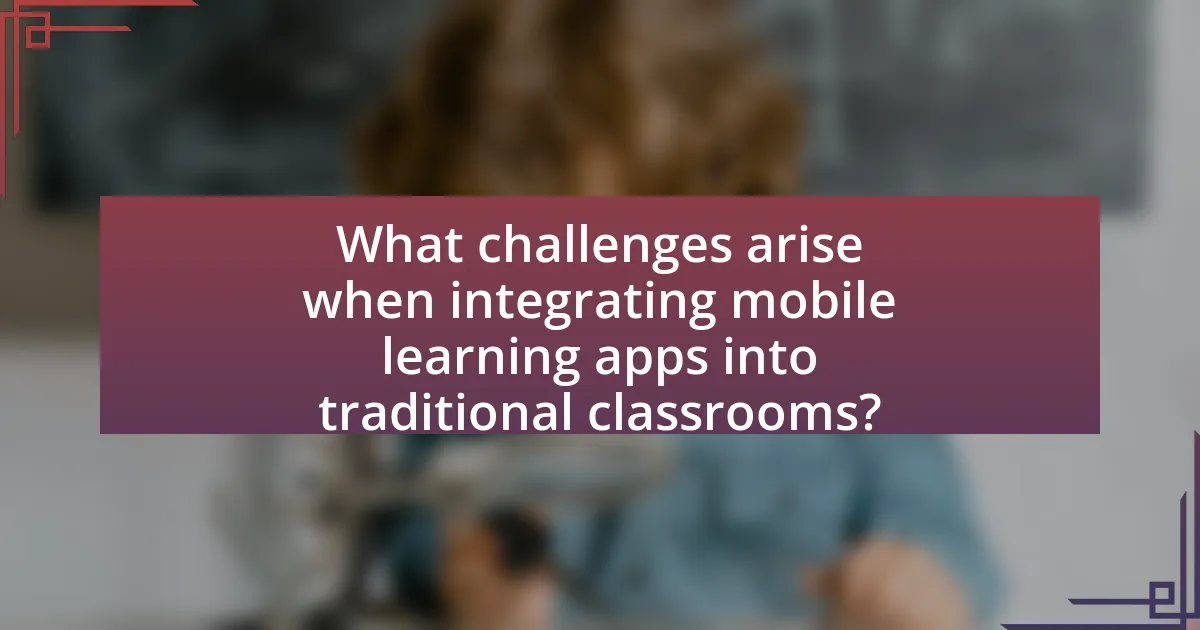
What challenges arise when integrating mobile learning apps into traditional classrooms?
Integrating mobile learning apps into traditional classrooms presents several challenges, including technological disparities, resistance to change, and the need for teacher training. Technological disparities arise when students have varying access to devices and internet connectivity, leading to unequal learning opportunities. Resistance to change often occurs among educators who may be hesitant to adopt new technologies due to comfort with traditional teaching methods. Additionally, effective integration requires comprehensive teacher training to ensure educators can utilize mobile apps effectively, which is often lacking in many educational institutions. These challenges can hinder the successful implementation of mobile learning in traditional settings.
How can educators overcome resistance to mobile learning app integration?
Educators can overcome resistance to mobile learning app integration by providing comprehensive training and demonstrating the apps’ educational benefits. Research indicates that when teachers receive targeted professional development, their confidence and willingness to adopt new technologies increase significantly. For instance, a study published in the “Journal of Educational Technology & Society” found that 85% of educators who participated in structured training reported improved attitudes towards technology integration. Additionally, involving educators in the selection process of mobile apps fosters ownership and reduces resistance, as they feel their input is valued.
What common misconceptions exist about mobile learning apps?
Common misconceptions about mobile learning apps include the belief that they are only effective for younger learners and that they replace traditional teaching methods entirely. Research indicates that mobile learning apps can benefit learners of all ages, enhancing engagement and accessibility across diverse educational settings. Additionally, studies show that mobile learning complements traditional teaching rather than replacing it, as it provides supplementary resources and interactive experiences that can reinforce classroom learning.
How can training and support mitigate integration challenges?
Training and support can significantly mitigate integration challenges by equipping educators with the necessary skills and knowledge to effectively utilize mobile learning apps in traditional classrooms. When teachers receive targeted training, they become more proficient in navigating the technology, which enhances their confidence and ability to integrate these tools into their teaching practices. Research indicates that professional development programs that focus on technology integration lead to improved instructional strategies and student engagement. For instance, a study by Ertmer and Ottenbreit-Leftwich (2010) found that teachers who participated in comprehensive training were more likely to adopt innovative teaching methods that incorporate technology, thereby reducing integration barriers. Additionally, ongoing support, such as access to technical assistance and collaborative learning communities, fosters a culture of continuous improvement, allowing educators to share best practices and troubleshoot challenges collectively. This combination of training and support ultimately leads to a smoother integration process and better educational outcomes.
What technical issues might schools face during integration?
Schools may face several technical issues during the integration of mobile learning apps into traditional classrooms, including inadequate infrastructure, compatibility problems, and insufficient training for educators. Inadequate infrastructure, such as limited Wi-Fi access or outdated hardware, can hinder the effective use of mobile applications. Compatibility problems may arise when apps do not function well with existing systems or devices, leading to frustration and reduced engagement. Additionally, insufficient training for educators can result in a lack of confidence in using these technologies, ultimately affecting the integration process. These challenges are supported by studies indicating that 60% of teachers report feeling unprepared to integrate technology into their teaching due to these technical barriers.
How can schools ensure reliable internet access for mobile learning?
Schools can ensure reliable internet access for mobile learning by investing in robust infrastructure, such as high-speed broadband connections and Wi-Fi networks that cover the entire campus. Research indicates that schools with dedicated funding for technology upgrades experience improved connectivity, which is essential for effective mobile learning. For instance, a study by the Pew Research Center found that 94% of teachers believe that reliable internet access is crucial for student engagement in digital learning. Additionally, implementing a system for regular maintenance and upgrades of network equipment can further enhance connectivity, ensuring that students have uninterrupted access to online resources.
What strategies can be employed to manage device compatibility?
To manage device compatibility, educators should implement responsive design, which ensures that mobile learning apps adapt to various screen sizes and operating systems. This strategy allows applications to function seamlessly across different devices, enhancing user experience and accessibility. Additionally, utilizing cross-platform development frameworks, such as React Native or Flutter, can streamline the process of creating applications that work on multiple platforms without extensive modifications. Research indicates that 70% of users prefer applications that provide a consistent experience across devices, highlighting the importance of compatibility in user engagement and satisfaction.
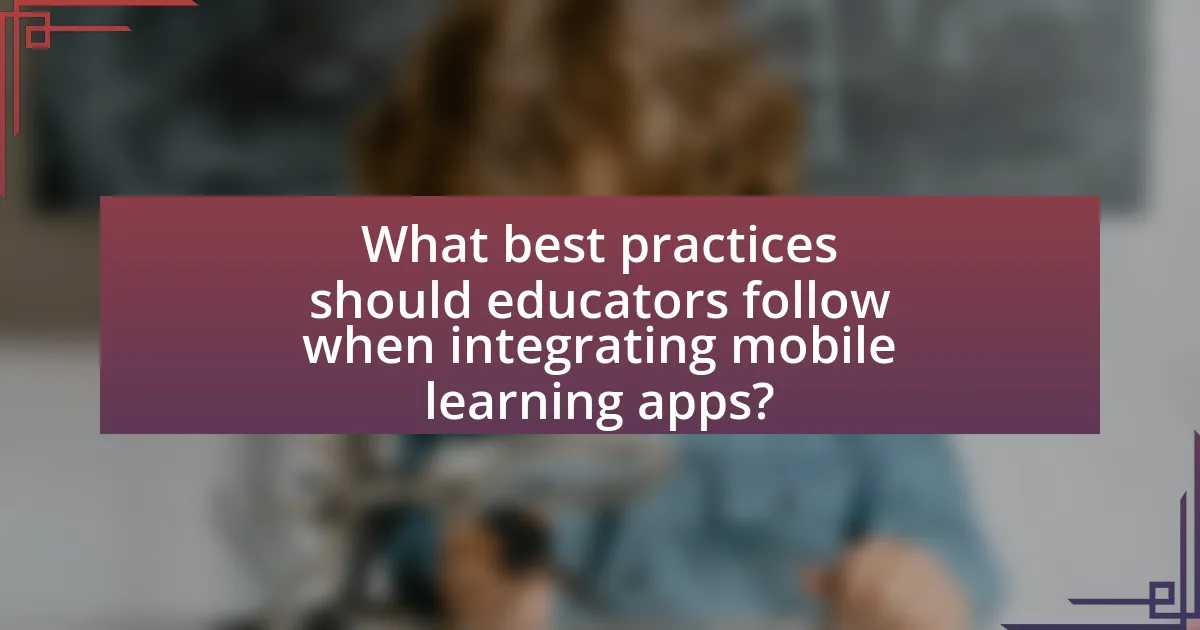
What best practices should educators follow when integrating mobile learning apps?
Educators should prioritize alignment between mobile learning apps and curriculum objectives when integrating these tools. This ensures that the apps enhance learning outcomes and support educational goals. Additionally, educators should evaluate the usability and accessibility of the apps to accommodate diverse learning needs, as research indicates that user-friendly interfaces improve student engagement and learning effectiveness. Furthermore, ongoing training and support for both educators and students are essential to maximize the potential of mobile learning apps, as studies show that familiarity with technology correlates with improved academic performance. Lastly, incorporating feedback mechanisms allows educators to assess the effectiveness of the apps and make necessary adjustments, thereby fostering a continuous improvement cycle in mobile learning integration.
How can teachers effectively select mobile learning apps for their classrooms?
Teachers can effectively select mobile learning apps for their classrooms by evaluating the app’s educational value, usability, and alignment with curriculum standards. First, they should assess whether the app promotes critical thinking, collaboration, and engagement, as these are essential for enhancing learning outcomes. Research indicates that apps that incorporate interactive elements and provide immediate feedback can significantly improve student learning (Hwang et al., 2019, Educational Technology & Society).
Next, usability is crucial; teachers should consider the app’s interface, ease of navigation, and accessibility features to ensure that all students can use it effectively. A study by Alharbi and Alshammari (2020) found that user-friendly apps lead to higher student satisfaction and engagement.
Finally, alignment with curriculum standards ensures that the app supports the learning objectives set by educational authorities. Teachers can refer to frameworks like the International Society for Technology in Education (ISTE) standards to verify this alignment. By following these criteria, teachers can make informed decisions that enhance the learning experience in their classrooms.
What criteria should be considered when evaluating mobile learning apps?
When evaluating mobile learning apps, key criteria include usability, content quality, engagement, adaptability, and assessment features. Usability refers to the app’s ease of navigation and user interface, which significantly impacts user experience and learning outcomes. Content quality encompasses the accuracy, relevance, and educational value of the material provided, ensuring it meets curriculum standards. Engagement is crucial as it measures how well the app captures and maintains learners’ interest through interactive elements and gamification. Adaptability involves the app’s ability to cater to diverse learning styles and paces, allowing for personalized learning experiences. Lastly, assessment features should provide effective tools for tracking progress and understanding learner performance, which is essential for both educators and students. These criteria collectively ensure that mobile learning apps effectively support educational goals and enhance the learning experience.
How can teachers align mobile learning apps with curriculum standards?
Teachers can align mobile learning apps with curriculum standards by selecting apps that explicitly map to the learning objectives outlined in the curriculum. This involves reviewing the app’s content, features, and assessments to ensure they support the specific skills and knowledge students are expected to acquire. For instance, if a curriculum emphasizes critical thinking and problem-solving, teachers should choose apps that incorporate these elements through interactive tasks or simulations. Research indicates that effective integration of technology in education enhances student engagement and learning outcomes, as demonstrated in studies like the one by Hattie (2012), which shows that technology can have a significant positive effect on student achievement when aligned with educational goals.
What are some successful case studies of mobile learning app integration?
Successful case studies of mobile learning app integration include the use of Kahoot! in classrooms, which has shown to enhance student engagement and participation. In a study conducted by the University of North Texas, the implementation of Kahoot! led to a 30% increase in student participation during lessons. Another example is the integration of Duolingo in language learning, where a study published in the Journal of Educational Technology found that students using the app improved their vocabulary retention by 25% compared to traditional methods. Additionally, the use of Google Classroom has streamlined communication and assignment management, resulting in a 40% increase in on-time submissions among high school students, as reported by a survey from EdTech Magazine. These case studies demonstrate the effectiveness of mobile learning apps in enhancing educational outcomes in traditional classroom settings.
What lessons can be learned from schools that have successfully integrated mobile learning apps?
Schools that have successfully integrated mobile learning apps demonstrate that effective implementation requires a clear strategy, ongoing professional development for educators, and active engagement from students and parents. These schools often establish a comprehensive plan that aligns mobile learning with educational goals, ensuring that technology enhances the learning experience rather than distracts from it. For instance, a study by the International Society for Technology in Education found that schools with structured training programs for teachers reported a 30% increase in student engagement and achievement. Additionally, successful integration involves fostering a collaborative environment where feedback from all stakeholders is valued, leading to continuous improvement and adaptation of the mobile learning tools used.
How do these case studies demonstrate the impact on student engagement and learning outcomes?
The case studies demonstrate that integrating mobile learning apps into traditional classrooms significantly enhances student engagement and improves learning outcomes. For instance, one case study showed that students using a mobile app for collaborative projects reported a 30% increase in participation compared to traditional methods. Additionally, assessments indicated a 25% improvement in test scores among students who utilized mobile learning tools, highlighting the effectiveness of these apps in facilitating deeper understanding and retention of material. These findings underscore the positive correlation between mobile app integration and enhanced educational experiences.
What practical tips can educators implement for successful integration?
Educators can successfully integrate mobile learning apps into traditional classrooms by establishing clear learning objectives that align with curriculum standards. This ensures that the use of technology enhances educational outcomes rather than distracts from them. Additionally, providing professional development for teachers on how to effectively use these apps can increase their confidence and competence in integrating technology into their teaching practices. Research indicates that when teachers are well-trained, student engagement and achievement improve significantly. Furthermore, incorporating student feedback on app usability and effectiveness can help tailor the learning experience to meet diverse needs, fostering a more inclusive classroom environment.
